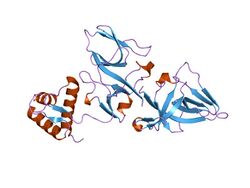Biology:Repressor lexA
| LexA DNA binding domain | |||||||||
|---|---|---|---|---|---|---|---|---|---|
 lexa s119a mutant | |||||||||
| Identifiers | |||||||||
| Symbol | LexA_DNA_bind | ||||||||
| Pfam | PF01726 | ||||||||
| Pfam clan | CL0123 | ||||||||
| InterPro | IPR006199 | ||||||||
| SCOP2 | 1leb / SCOPe / SUPFAM | ||||||||
| |||||||||
Repressor LexA or LexA (Locus for X-ray sensitivity A)[1] is a transcriptional repressor (EC 3.4.21.88) that represses SOS response genes coding primarily for error-prone DNA polymerases, DNA repair enzymes and cell division inhibitors.[2] LexA forms de facto a two-component regulatory system with RecA, which senses DNA damage at stalled replication forks, forming monofilaments and acquiring an active conformation capable of binding to LexA and causing LexA to cleave itself, in a process called autoproteolysis.[3]
DNA damage can be inflicted by the action of antibiotics, bacteriophages, and UV light.[2] Of potential clinical interest is the induction of the SOS response by antibiotics, such as ciprofloxacin. Bacteria require topoisomerases such as DNA gyrase or topoisomerase IV for DNA replication. Antibiotics such as ciprofloxacin are able to prevent the action of these molecules by attaching themselves to the gyrate–DNA complex, leading to replication fork stall and the induction of the SOS response. The expression of error-prone polymerases under the SOS response increases the basal mutation rate of bacteria. While mutations are often lethal to the cell, they can also enhance survival. In the specific case of topoisomerases, some bacteria have mutated one of their amino acids so that the ciprofloxacin can only create a weak bond to the topoisomerase. This is one of the methods that bacteria use to become resistant to antibiotics. Ciprofloxacin treatment can therefore potentially lead to the generation of mutations that may render bacteria resistant to ciprofloxacin. In addition, ciprofloxacin has also been shown to induce via the SOS response dissemination of virulence factors [4] and antibiotic resistance determinants,[5] as well as the activation of integron integrases,[6] potentially increasing the likelihood of acquisition and dissemination of antibiotic resistance by bacteria.[2]
Impaired LexA proteolysis has been shown to interfere with ciprofloxacin resistance.[7] This offers potential for combination therapy that combines quinolones with strategies aimed at interfering with the action of LexA, either directly or via RecA.
LexA contains a DNA binding domain. The winged HTH motif of LexA is a variant form of the helix-turn-helix DNA binding motif,[8] and it is usually located at the N-terminus of the protein.[3]
References
- ↑ Butala, M.; Žgur-Bertok, D.; Busby, S. J. W. (January 2009). "The bacterial LexA transcriptional repressor" (in en). Cellular and Molecular Life Sciences 66 (1): 82–93. doi:10.1007/s00018-008-8378-6. ISSN 1420-682X. PMID 18726173. http://link.springer.com/10.1007/s00018-008-8378-6.
- ↑ 2.0 2.1 2.2 "Aeons of distress: an evolutionary perspective on the bacterial SOS response". FEMS Microbiol. Rev. 31 (6): 637–656. 2007. doi:10.1111/j.1574-6976.2007.00082.x. PMID 17883408.
- ↑ 3.0 3.1 "The bacterial LexA transcriptional repressor". Cell Mol Life Sci 66 (1): 82–93. 2009. doi:10.1007/s00018-008-8378-6. PMID 18726173.
- ↑ "Antibiotic-induced SOS response promotes horizontal dissemination of pathogenicity island-encoded virulence factors in staphylococci". Mol. Microbiol. 56 (3): 836–844. 2005. doi:10.1111/j.1365-2958.2005.04584.x. PMID 15819636.
- ↑ "SOS response promotes horizontal dissemination of antibiotic resistance genes". Nature 427 (6969): 72–74. 2004. doi:10.1038/nature02241. PMID 14688795. Bibcode: 2004Natur.427...72B.
- ↑ "The SOS response controls integron recombination". Science 324 (5930): 1034. 2009. doi:10.1126/science.1172914. PMID 19460999. Bibcode: 2009Sci...324.1034G.
- ↑ "Inhibition of mutation and combating the evolution of antibiotic resistance". PLOS Biol. 3 (6): e176. 2005. doi:10.1371/journal.pbio.0030176. PMID 15869329.
- ↑ "Solution structure of the LexA repressor DNA binding domain determined by 1H NMR spectroscopy". EMBO J. 13 (17): 3936–44. September 1994. doi:10.1002/j.1460-2075.1994.tb06709.x. PMID 8076591.
 |

